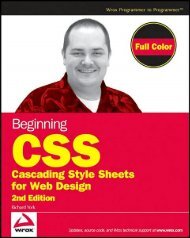O Guia Definitivo do Yii 1.1
O Guia Definitivo do Yii 1.1
O Guia Definitivo do Yii 1.1
You also want an ePaper? Increase the reach of your titles
YUMPU automatically turns print PDFs into web optimized ePapers that Google loves.
• A test method usually contains a sequence of statements that would issue commands<br />
to Selenium RC to interact with the Web application being tested. It also contains<br />
assertion statements to verify that the Web application responds as expected.<br />
Before we describe how to write a functional test, let's take a look at the WebTestCase.php<br />
file generated by the yiic webapp command. This file defines WebTestCase that may serve<br />
as the base class for all functional test classes.<br />
define('TEST_BASE_URL','http://localhost/yii/demos/blog/index-test.php/');<br />
class WebTestCase extends CWebTestCase<br />
{<br />
/**<br />
* Sets up before each test method runs.<br />
* This mainly sets the base URL for the test application.<br />
*/<br />
protected function setUp()<br />
{<br />
parent::setUp();<br />
$this->setBrowserUrl(TEST_BASE_URL);<br />
}<br />
}<br />
......<br />
The class WebTestCase mainly sets the base URL of the pages to be tested. Later in test<br />
methods, we can use relative URLs to specify which pages to be tested.<br />
We should also pay attention that in the base test URL, we use index-test.php as the entry<br />
script instead ofindex.php. The only difference between index-test.php and index.php is<br />
that the former uses test.phpas the application configuration file while the latter main.php.<br />
We now describe how to test the feature about showing a post in the blog demo. We first<br />
write the test class as follows, noting that the test class extends from the base class we<br />
just described:










